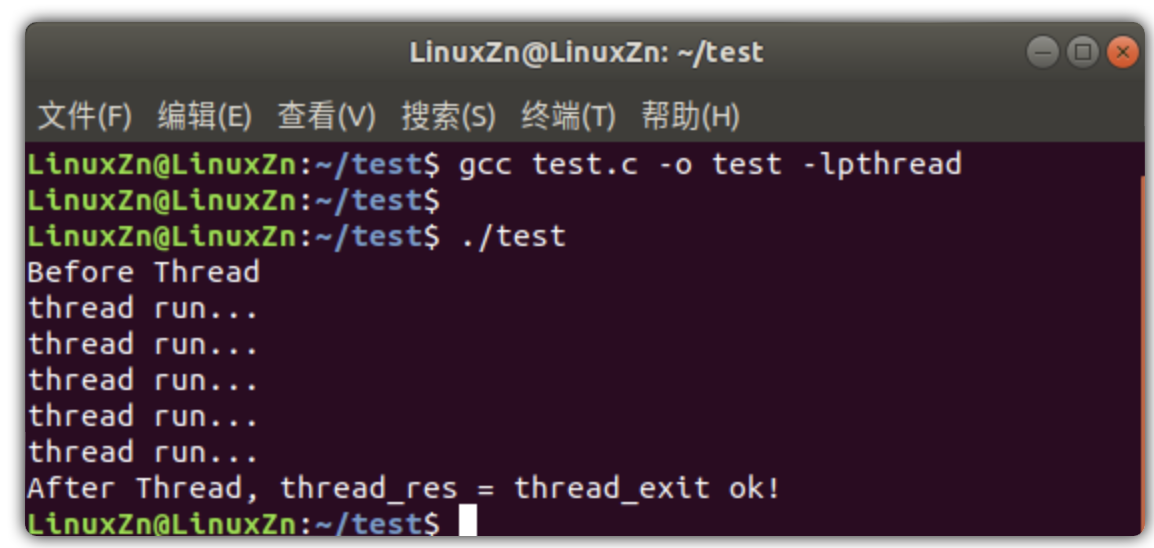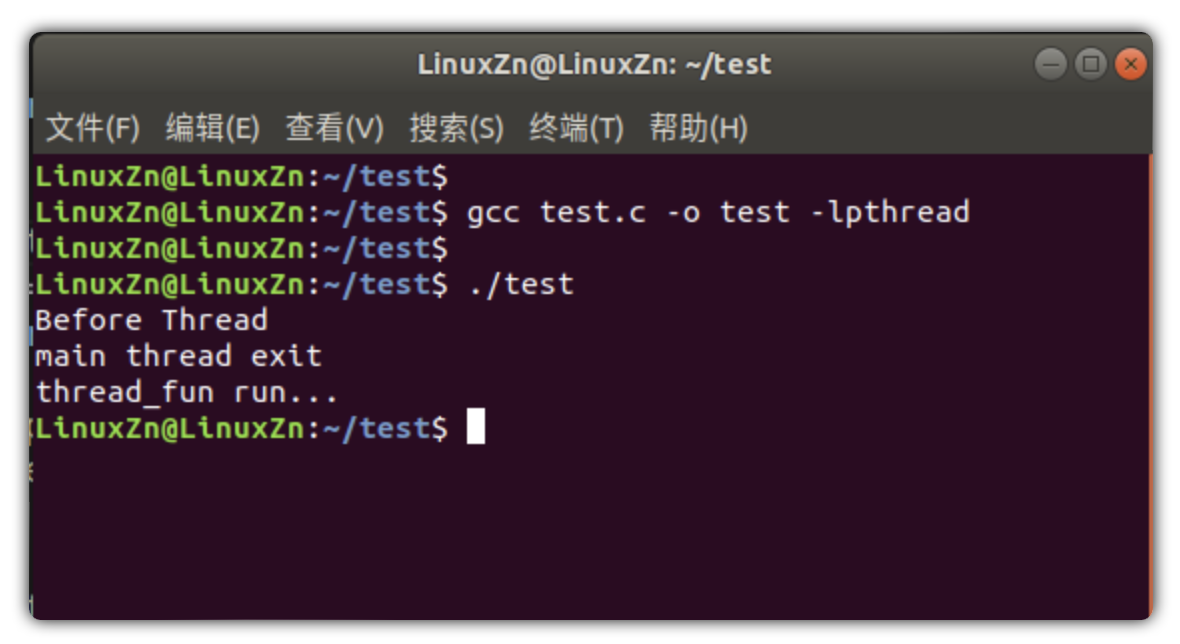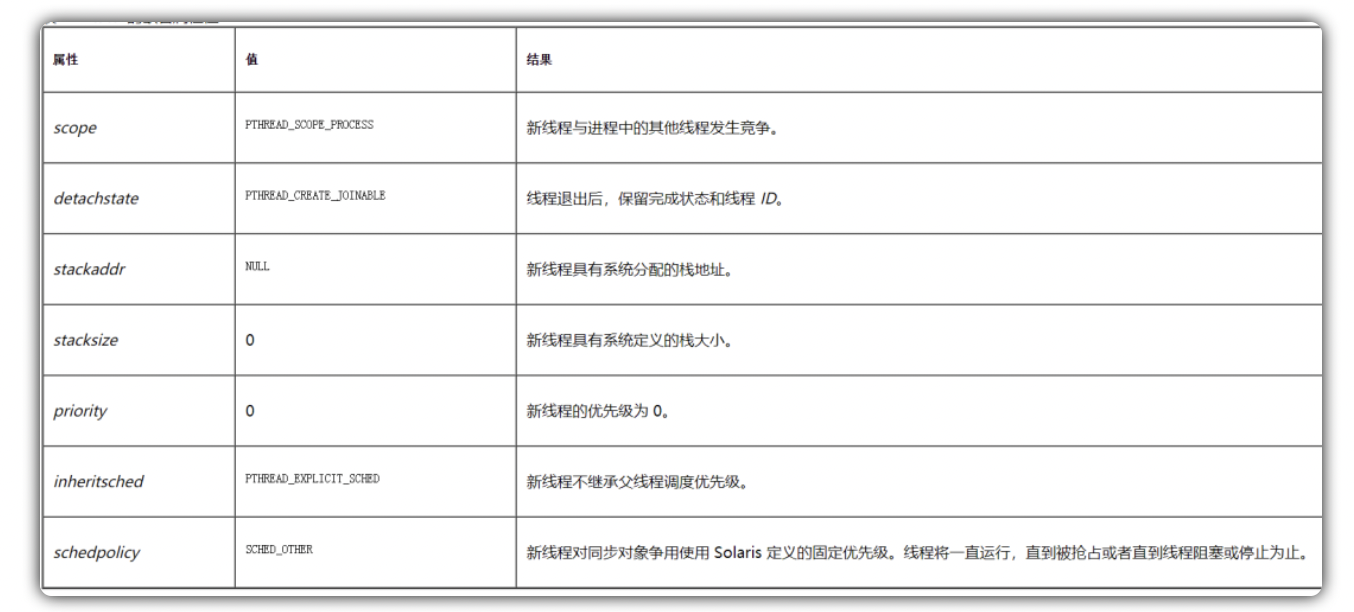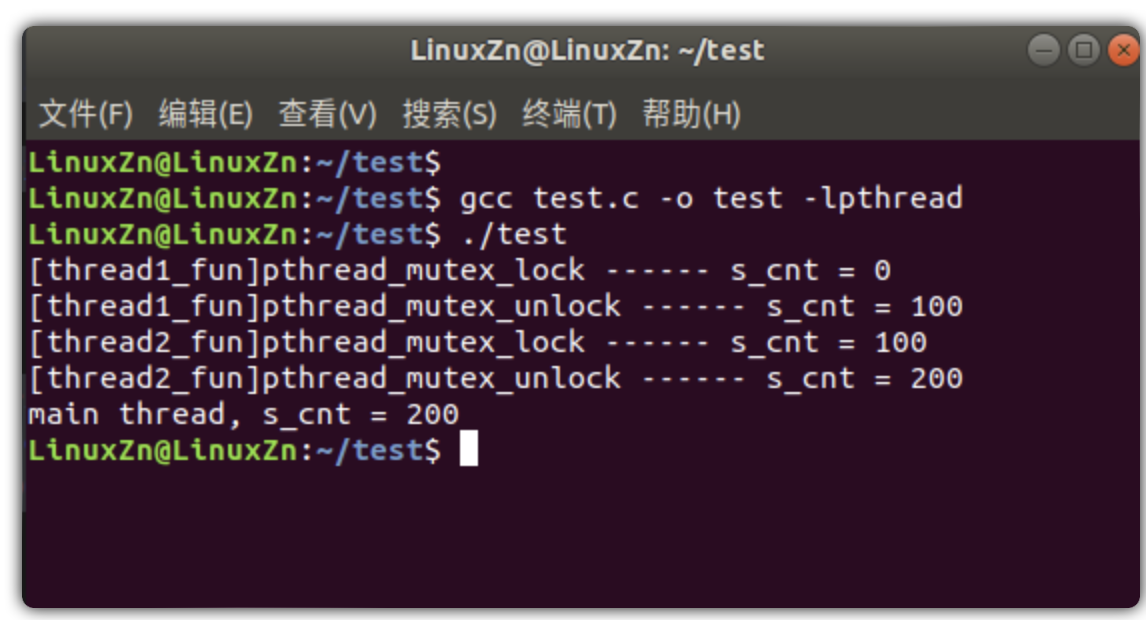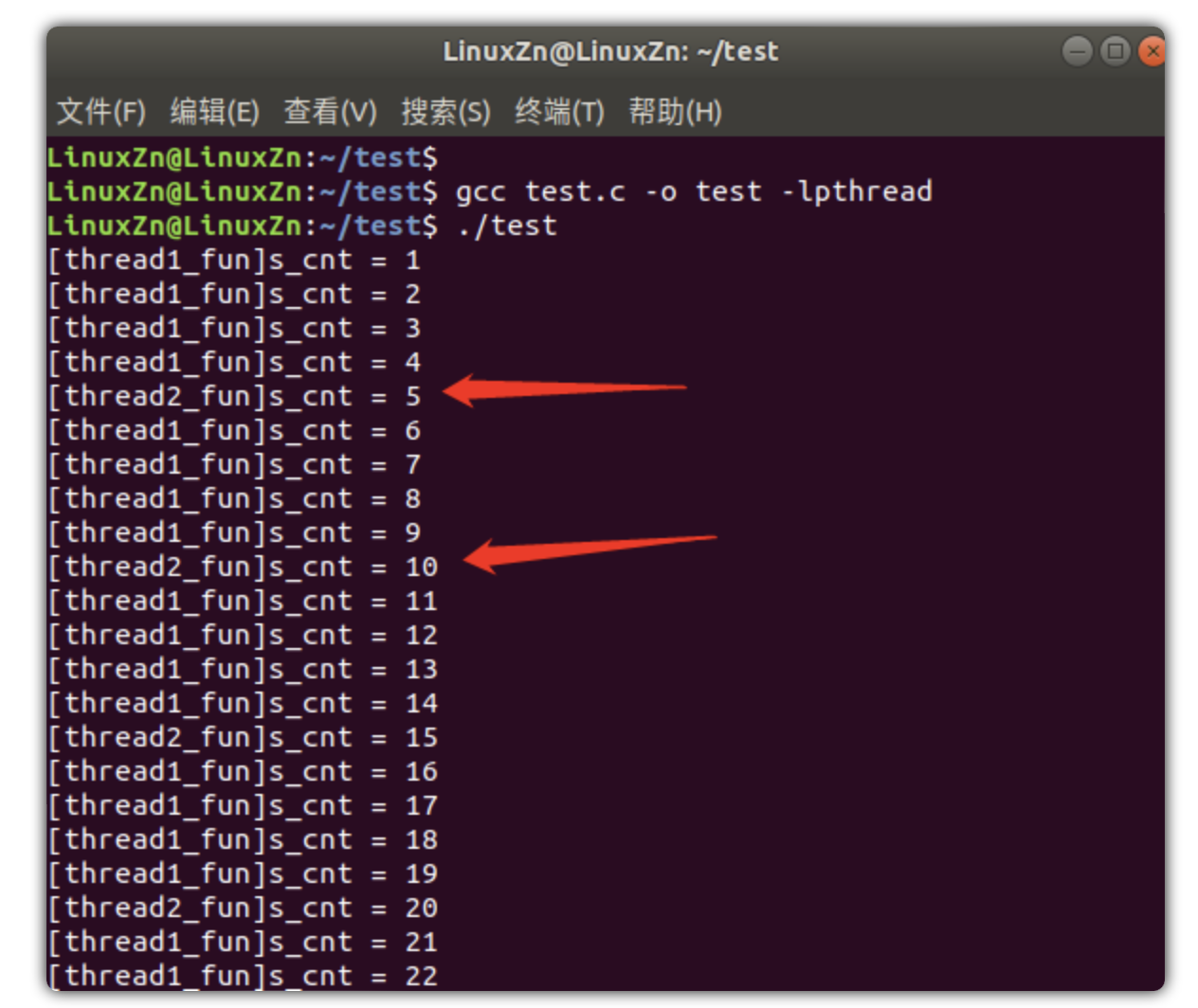什么是多线程编程?
1、线程和进程的区别
进程是指正在运行的程序,它拥有独立的内存空间和系统资源,不同进程之间的数据不共享。
线程是进程内的执行单元,它与同一进程内的其他线程共享进程的内存空间和系统资源。
2、多线程的优势和应用场景
多线程是一种并发编程方式,它的优势包括:
- 提高程序的响应速度和运行效率(多核CPU下的多线程)
- 充分利用CPU资源,提高系统的利用率
- 支持多个任务并行执行,提高程序的可扩展性和可维护性
Linux下的多线程编程
Linux下C语言多线程编程依赖于pthread多线程库。pthread库是Linux的多线程库,是POSIX标准线程API的实现,它提供了一种创建和操纵线程的方法,以及一些同步机制,如互斥锁、条件变量等。
头文件:
`#include <pthread.h>
`编译链接需要链接链接库 pthread。
一、线程的基本操作
1、pthread_create
/**
* @brief 创建一个线程
*
* Detailed function description
*
* @param[in] thread: 一个指向线程标识符的指针,线程调用后,该值被设置为线程ID;pthread_t为unsigned long int
* @param[in] attr: 用来设置线程属性
* @param[in] start_routine: 线程函数体,线程创建成功后,thread 指向的内存单元从该地址开始运行
* @param[in] arg: 传递给线程函数体的参数
*
* @return 线程创建成功,则返回0,失败则返回错误码,并且 thread 内容是未定义的
*/
int pthread_create(pthread_t* thread, const pthread_attr_t* attr, void*(*start_routine)(void*), void* arg);例子test.c:创建一个线程,每1s打印一次。
`#include <stdio.h>
#include <stdlib.h>
#include <unistd.h>
#include <pthread.h>
static pthread_t s_thread_id;
static unsigned char s_thread_running = 0;
void *thread_fun(void *arg)
{
s_thread_running = 1;
while (s_thread_running)
{
printf("thread run...\n");
sleep(1);
}
pthread_exit(NULL);
}
int main(void)
{
int ret = 0;
printf("Before Thread\n");
ret = pthread_create(&s_thread_id, NULL, thread_fun, NULL);
if (ret != 0)
{
printf("thread_create error!\n");
exit(EXIT_FAILURE);
}
ret = pthread_join(s_thread_id, NULL); ///< 阻塞等待线程结束
if (ret != 0)
{
printf("pthread_join error!\n");
exit(EXIT_FAILURE);
}
printf("After Thread\n");
exit(EXIT_SUCCESS);
}
`编译、运行:
`gcc test.c -o test -lpthread
`2、pthread_join
`/**
* @brief 等待某个线程结束
*
* Detailed function description: 这是一个线程阻塞函数,调用该函数则等到线程结束才继续运行
*
* @param[in] thread: 某个线程的ID
* @param[in] retval: 用于获取线程 start_routine 的返回值
*
* @return 线程创建成功,则返回0,失败则返回错误码,并且 thread 内容是未定义的
*/
int pthread_join(pthread_t thread, void **retval);
`例子test.c:创建一个线程,进行一次加法运算就返回。
`#include <stdio.h>
#include <stdlib.h>
#include <unistd.h>
#include <pthread.h>
static pthread_t s_thread_id;
static unsigned char s_thread_running = 0;
void *thread_fun(void *arg)
{
static int res = 0;
int a = 1, b = 2;
res = a + b;
sleep(1);
printf("thread run, a + b = %d, addr = %p\n", res, &res);
pthread_exit(&res);
}
int main(void)
{
int ret = 0;
int *retval = NULL;
printf("Before Thread\n");
ret = pthread_create(&s_thread_id, NULL, thread_fun, NULL);
if (ret != 0)
{
printf("pthread_create error!\n");
exit(EXIT_FAILURE);
}
ret = pthread_join(s_thread_id, (void **)&retval); ///< 阻塞等待线程结束
if (ret != 0)
{
printf("pthread_join error!\n");
exit(EXIT_FAILURE);
}
if (retval != NULL)
{
printf("After Thread, retval = %d, addr = %p\n", (int)*retval, retval);
}
exit(EXIT_SUCCESS);
}
`编译、运行:
3、pthread_exit
`/**
* @brief 退出线程
*
* Detailed function description
*
* @param[in] retval: 它指向的数据将作为线程退出时的返回值
*
* @return void
*/
void pthread_exit(void *retval);
`
- 线程将指定函数体中的代码执行完后自行结束;
- 线程执行过程中,被同一进程中的其它线程(包括主线程)强制终止;
- 线程执行过程中,遇到 pthread_exit() 函数结束执行。
例子test.c:创建一个线程,每个1s打印一次,打印超过5次时调用pthread_exit退出。
#include <stdio.h>
#include <stdlib.h>
#include <unistd.h>
#include <pthread.h>
static pthread_t s_thread_id;
static unsigned char s_thread_running = 0;
const static char *thread_exit_str = "thread_exit ok!";
void *thread_fun(void *arg)
{
static int cnt = 0;
s_thread_running = 1;
while (s_thread_running)
{
cnt++;
if (cnt > 5)
{
pthread_exit((void*)thread_exit_str);
}
printf("thread run...\n");
sleep(1);
}
pthread_exit(NULL);
}
int main(void)
{
int ret = 0;
void *thread_res = NULL;
printf("Before Thread\n");
ret = pthread_create(&s_thread_id, NULL, thread_fun, NULL);
if (ret != 0)
{
printf("thread_create error!\n");
exit(EXIT_FAILURE);
}
ret = pthread_join(s_thread_id, (void**)&thread_res);
if (ret != 0)
{
printf("thread_join error!\n");
exit(EXIT_FAILURE);
}
printf("After Thread, thread_res = %s\n", (char*)thread_res);
exit(EXIT_SUCCESS);
} 编译、运行:
使用return退出线程与使用pthread_exit退出线程的区别?
return为通用的函数退出操作,pthread_exit专用与线程,既然pthread库有提供专门的函数,自然用pthread_exit会好些,虽然使用return也可以。
看看return退出线程与使用pthread_exit退出线程的具体区别:退出主线程。使用pthread_exit退出主线程只会终止当前线程,不会影响进程中其它线程的执行;使用return退出主线程,主线程退出执行很快,所有线程都会退出。
例子:使用pthread_exit退出主线程
`#include <stdio.h>
#include <stdlib.h>
#include <unistd.h>
#include <pthread.h>
static pthread_t s_thread_id;
static unsigned char s_thread_running = 0;
const static char *thread_exit_str = "thread_exit ok!";
void *thread_fun(void *arg)
{
sleep(1);
printf("thread_fun run...\n");
pthread_exit(NULL);
}
int main(void)
{
int ret = 0;
void *thread_res = NULL;
printf("Before Thread\n");
ret = pthread_create(&s_thread_id, NULL, thread_fun, NULL);
if (ret != 0)
{
printf("thread_create error!\n");
exit(EXIT_FAILURE);
}
printf("main thread exit\n");
pthread_exit(NULL);
}
`编译、运行:
例子:使用return退出主线程
`#include <stdio.h>
#include <stdlib.h>
#include <unistd.h>
#include <pthread.h>
static pthread_t s_thread_id;
static unsigned char s_thread_running = 0;
const static char *thread_exit_str = "thread_exit ok!";
void *thread_fun(void *arg)
{
sleep(1);
printf("thread_fun run...\n");
pthread_exit(NULL);
}
int main(void)
{
int ret = 0;
void *thread_res = NULL;
printf("Before Thread\n");
ret = pthread_create(&s_thread_id, NULL, thread_fun, NULL);
if (ret != 0)
{
printf("thread_create error!\n");
exit(EXIT_FAILURE);
}
printf("main thread exit\n");
return 0;
}
`编译、运行:
4、pthread_self
`/**
* @brief 用来获取当前线程ID
*
* Detailed function description
*
* @param[in] void
*
* @return 返回线程id
*/
pthread_t pthread_self(void);
`例子:
#include <stdio.h>
#include <stdlib.h>
#include <unistd.h>
#include <pthread.h>
static pthread_t s_thread_id;
static unsigned char s_thread_running = 0;
const static char *thread_exit_str = "thread_exit ok!";
void *thread_fun(void *arg)
{
static int cnt = 0;
s_thread_running = 1;
while (s_thread_running)
{
cnt++;
if (cnt > 5)
{
pthread_exit((void*)thread_exit_str);
}
printf("thread run(tid = %ld)...\n", pthread_self());
sleep(1);
}
pthread_exit(NULL);
}
int main(void)
{
int ret = 0;
void *thread_res = NULL;
pid_t pid = getpid();
printf("pid = %d\n", pid);
printf("Before Thread\n");
ret = pthread_create(&s_thread_id, NULL, thread_fun, NULL);
if (ret != 0)
{
printf("thread_create error!\n");
exit(EXIT_FAILURE);
}
ret = pthread_join(s_thread_id, (void**)&thread_res);
if (ret != 0)
{
printf("thread_join error!\n");
exit(EXIT_FAILURE);
}
printf("After Thread, thread_res = %s\n", (char*)thread_res);
exit(EXIT_SUCCESS);
}
编译、运行:
5、pthraad_detach
/**
* @brief 分离线程
*
* Detailed function description: 分离线程,线程结束是系统自动回收线程的资源
*
* @param[in] thread: 某个线程的ID
*
* @return 成功时返回0,失败返回其他值
*/
int pthread_detach(pthread_t thread);
pthread_create创建的线程有两种状态:joinable(可结合的)和unjoinable(不可结合的/分离的)。默认是joinable 状态。
一个可结合的线程能够被其他线程收回其资源和杀死;在被其他线程回收之前,它的存储器资源(如栈)是不释放的,所以以默认的属性创建线程时,创建的线程时可结合的,我们需要对线程退出时调用pthread_join对线程资源进行回收。只有当pthread_join函数返回时,创建的线程才算终止,才能释放自己占用的系统资源。
一个不可结合的线程,线程结束后会自动释放占用资源。
因为pthread_join是一个阻塞的操作,而大多数时候主线程并不希望因为调用pthread_join而阻塞,并且大多数情况下不会使用线程函数体的返回值,所以这时候可以把线程创建为不可结合的/分离的。
把线程创建为不可结合的/分离的有两种方式:
- 在创建线程之后,使用pthraad_detach分离线程。
- 在创建线程之前,使用pthread_attr_setdetachstate设置线程以不可结合的/分离的状态创建。
例子:在创建线程之后,使用pthraad_detach分离线程。
#include <stdio.h>
#include <stdlib.h>
#include <unistd.h>
#include <pthread.h>
static pthread_t s_thread_id;
static unsigned char s_thread_running = 0;
void *thread_fun(void *arg)
{
s_thread_running = 1;
while (s_thread_running)
{
printf("child thread run...\n");
sleep(1);
}
pthread_exit(NULL);
}
int main(void)
{
int ret = 0;
printf("Before Thread\n");
ret = pthread_create(&s_thread_id, NULL, thread_fun, NULL);
if (ret != 0)
{
printf("thread_create error!\n");
exit(EXIT_FAILURE);
}
ret = pthread_detach(s_thread_id);
if (ret != 0)
{
printf("pthread_detach error!\n");
exit(EXIT_FAILURE);
}
printf("After Thread\n");
while (1)
{
printf("main thread run...\n");
sleep(1);
}
exit(EXIT_SUCCESS);
}
编译、运行:
pthread_join与pthraad_detach的区别:
- pthread_detach()即主线程与子线程分离,两者相互不干涉,子线程结束同时子线程的资源自动回收。
- pthread_join()即是子线程合入主线程,主线程会一直阻塞,直到子线程执行结束,然后回收子线程资源,并继续执行。
6、pthread_attr_init
`/**
* @brief 初始化一个线程对象的属性
*
* Detailed function description
*
* @param[in] attr: 指向一个线程属性的指针
*
* @return 成功时返回0,失败返回其他值
*/
int pthread_attr_init(pthread_attr_t *attr);
`如果不设置线程属性,线程则以默认属性进行创建,默认的属性值如:
例子:在创建线程之前,使用pthread_attr_setdetachstate设置线程以不可结合的/分离的状态创建。
`#include <stdio.h>
#include <stdlib.h>
#include <unistd.h>
#include <pthread.h>
static pthread_t s_thread_id;
static unsigned char s_thread_running = 0;
void *thread_fun(void *arg)
{
s_thread_running = 1;
while (s_thread_running)
{
printf("thread run...\n");
sleep(1);
}
pthread_exit(NULL);
}
int main(void)
{
int ret = 0;
printf("Before Thread\n");
pthread_attr_t attr;
ret = pthread_attr_init(&attr);
if (ret != 0)
{
printf("pthread_attr_init error!\n");
exit(EXIT_FAILURE);
}
pthread_attr_setdetachstate(&attr, PTHREAD_CREATE_DETACHED); ///< 线程以分离的状态创建
ret = pthread_create(&s_thread_id, &attr, thread_fun, NULL);
if (ret != 0)
{
printf("thread_create error!\n");
exit(EXIT_FAILURE);
}
printf("After Thread\n");
pthread_attr_destroy(&attr); ///< 销毁线程属性结构
while (1)
{
sleep(1);
}
exit(EXIT_SUCCESS);
}
`二、互斥锁(mutex)的使用
互斥锁用于保护一些公共资源。一些公共资源有可能会被多个线程共同使用,如果不做资源保护,可能会产生 意想不到的bug。
一个线程,如果需要访问公共资源,需要获得互斥锁并对其加锁,资源在在锁定过程中,如果其它线程对其进行访问,也需要获得互斥锁,如果获取不到,线程只能进行阻塞,直到获得该锁的线程解锁。
互斥锁API:
`#include<pthread.h>
///< 创建互斥对象,用指定的初始化属性初始化互斥对象
int pthread_mutex_init(pthread_mutex_t *mutex,
const pthread_mutex_attr_t *mutexattr);
///< 加锁
int pthread_mutex_lock(pthread_mutex_t *mutex);
///< 解锁
int pthread_mutex_unlock(pthread_mutex_t *mutex);
///< 加锁,但是如果对象已经上锁则返回EBUSY错误代码而不阻塞
int pthread_mmutex_trylock(pthread_mutex_t *mutex);
///< 析构并释放mutex相关资源
int pthread_mutex_destroy(pthread_mutex_t *mutex);
`互斥锁有两种创建方式:
- 静态创建:
pthread_mutex_t mutex = PTHREAD_MUTEX_INITIALIZER; - 动态创建:
`pthread_mutex_t mutex;
pthread_mutex_init(&mutex, NULL);
`pthread互斥锁属性包括:
- PTHREAD_MUTEX_TIMED_NP:这是缺省值,也就是普通锁。当一个线程加锁以后,其余请求锁的线程将会形成一个等待队列,并在解锁后按优先级获得锁。这种策略可以确保资源分配的公平性。
- PTHREAD_MUTEX_RECURSIVE_NP:嵌套锁。允许同一个线程对同一个锁成功获得多次,并通过unlock解锁。如果是不同线程请求,则在加锁线程解锁时重新竞争。
- PTHREAD_MUTEX_ERRORCHECK_NP:检错锁。如果同一个线程请求同一个锁,则返回EDEADLK,否则与PTHREAD_MUTEX_TIMED_NP类型动作相同,这样就保证了当不允许多次加锁时不会出现最简单情况下的死锁。
- PTHREAD\_MUTEX_ADAPTIVE_NP:适应锁,动作最简单的锁类型,仅等待一小段时间,如果不能获得锁就放弃等待
互斥锁使用形式:
`pthread_mutex_t mutex;
pthread_mutex_init(&mutex,NULL); ///< 初始化互斥锁
pthread_mutex_lock(&mutex); ///< 加锁
///< 操作公共资源
pthread_mutex_unlock(&mutex); ///< 解锁
pthread_mutex_destroy(&mutex); ///< 销毁互斥锁
`例子:
`#include <stdio.h>
#include <stdlib.h>
#include <unistd.h>
#include <pthread.h>
static pthread_t s_thread1_id;
static pthread_t s_thread2_id;
static unsigned char s_thread1_running = 0;
static unsigned char s_thread2_running = 0;
static pthread_mutex_t s_mutex;
static int s_cnt = 0;
void *thread1_fun(void *arg)
{
printf("[%s]pthread_mutex_lock ------ s_cnt = %d\n", __FUNCTION__, s_cnt);
pthread_mutex_lock(&s_mutex); ///< 加锁
for (size_t i = 0; i < 100; i++)
{
s_cnt++;
}
printf("[%s]pthread_mutex_unlock ------ s_cnt = %d\n", __FUNCTION__, s_cnt);
pthread_mutex_unlock(&s_mutex); ///< 解锁
pthread_exit(NULL);
}
void *thread2_fun(void *arg)
{
printf("[%s]pthread_mutex_lock ------ s_cnt = %d\n", __FUNCTION__, s_cnt);
pthread_mutex_lock(&s_mutex); ///< 加锁
for (size_t i = 0; i < 100; i++)
{
s_cnt++;
}
printf("[%s]pthread_mutex_unlock ------ s_cnt = %d\n", __FUNCTION__, s_cnt);
pthread_mutex_unlock(&s_mutex); ///< 解锁
pthread_exit(NULL);
}
int main(void)
{
int ret = 0;
///< 创建互斥量
ret = pthread_mutex_init(&s_mutex, NULL);
if (ret != 0)
{
printf("pthread_mutex_init error!\n");
exit(EXIT_FAILURE);
}
///< 创建线程1
ret = pthread_create(&s_thread1_id, NULL, thread1_fun, NULL);
if (ret != 0)
{
printf("thread1_create error!\n");
exit(EXIT_FAILURE);
}
ret = pthread_join(s_thread1_id, NULL); ///< 阻塞等待线程结束
if (ret != 0)
{
printf("pthread1_join error!\n");
exit(EXIT_FAILURE);
}
///< 创建线程2
ret = pthread_create(&s_thread2_id, NULL, thread2_fun, NULL);
if (ret != 0)
{
printf("thread2_create error!\n");
exit(EXIT_FAILURE);
}
ret = pthread_join(s_thread2_id, NULL); ///< 阻塞等待线程结束
if (ret != 0)
{
printf("pthread2_join error!\n");
exit(EXIT_FAILURE);
}
printf("main thread, s_cnt = %d\n", s_cnt);
ret = pthread_mutex_destroy(&s_mutex);
{
printf("pthread_mutex_destroy error!\n");
exit(EXIT_FAILURE);
}
return 0;
}
`编译、运行:
三、条件变量的使用
条件变量是在线程中以睡眠的方式等待某一条件的发生,是利用线程间共享的全局变量进行同步的一种机制。
条件变量是线程可用的一种同步机制,条件变量给多个线程提供了一个会合的场所,条件变量与互斥量一起使用时,允许线程以无竞争的方式等待特定的条件发生。
条件变量API:
#include <pthread.h>
///< 条件变量初始化
int pthread_cond_init(pthread_cond_t *restrict cond, const pthread_condattr_t *restrict attr);
///< 销毁条件变量
int pthread_cond_destroy(pthread_cond_t *cond);
///< 等待条件变量
int pthread_cond_wait(pthread_cond_t *restrict cond, pthread_mutex_t *restrict mutex);
///< 带有超时功能的 等待条件变量
int pthread_cond_timedwait(pthread_cond_t *restrict cond,
pthread_mutex_t *restrict mutex,
const struct timespec *restrict tsptr);
///< 通知条件变量,唤醒至少1个等待该条件的线程
int pthread_cond_signal(pthread_cond_t *cond);
///< 通知条件变量,广播唤醒等待该条件的所有线程
int pthread_cond_broadcast(pthread_cond_t *cond); 假如有两个线程,线程1依赖于某个变量才能执行相应的操作,而这个变量正好是由线程2来改变的。这种情况下有两种方案编写程序:
方案一:线程1轮询的方式检测这个变量是否变化,变化则执行相应的操作。
方案二:使用条件变量的方式。线程1等待线程2满足条件时进行唤醒。
其中,方案一比较浪费CPU资源。
条件变量的例子:创建两个线程,线程1对全局计数变量cnt从0开始进行自增操作。线程2打印5的倍数,线程1打印其它数。
`#include <stdio.h>
#include <stdlib.h>
#include <unistd.h>
#include <pthread.h>
static pthread_t s_thread1_id;
static pthread_t s_thread2_id;
static unsigned char s_thread1_running = 0;
static unsigned char s_thread2_running = 0;
static pthread_mutex_t s_mutex;
static pthread_cond_t s_cond;
static int s_cnt = 0;
void *thread1_fun(void *arg)
{
s_thread1_running = 1;
while (s_thread1_running)
{
pthread_mutex_lock(&s_mutex); ///< 加锁
s_cnt++;
pthread_mutex_unlock(&s_mutex); ///< 解锁
if (s_cnt % 5 == 0)
{
pthread_cond_signal(&s_cond); ///< 唤醒其它等待该条件的线程
}
else
{
printf("[%s]s_cnt = %d\n", __FUNCTION__, s_cnt);
}
usleep(100 * 1000);
}
pthread_exit(NULL);
}
void *thread2_fun(void *arg)
{
s_thread2_running = 1;
while (s_thread2_running)
{
pthread_mutex_lock(&s_mutex); ///< 加锁
while (s_cnt % 5 != 0)
{
pthread_cond_wait(&s_cond, &s_mutex); ///< 等待条件变量
}
printf("[%s]s_cnt = %d\n", __FUNCTION__, s_cnt);
pthread_mutex_unlock(&s_mutex); ///< 解锁
usleep(200 * 1000);
}
pthread_exit(NULL);
}
int main(void)
{
int ret = 0;
///< 创建互斥量
ret = pthread_mutex_init(&s_mutex, NULL);
if (ret != 0)
{
printf("pthread_mutex_init error!\n");
exit(EXIT_FAILURE);
}
///< 创建条件变量
ret = pthread_cond_init(&s_cond, NULL);
if (ret != 0)
{
printf("pthread_cond_init error!\n");
exit(EXIT_FAILURE);
}
///< 创建线程1
ret = pthread_create(&s_thread1_id, NULL, thread1_fun, NULL);
if (ret != 0)
{
printf("thread1_create error!\n");
exit(EXIT_FAILURE);
}
ret = pthread_detach(s_thread1_id);
if (ret != 0)
{
printf("s_thread1_id error!\n");
exit(EXIT_FAILURE);
}
///< 创建线程2
ret = pthread_create(&s_thread2_id, NULL, thread2_fun, NULL);
if (ret != 0)
{
printf("thread2_create error!\n");
exit(EXIT_FAILURE);
}
ret = pthread_detach(s_thread2_id);
if (ret != 0)
{
printf("s_thread2_id error!\n");
exit(EXIT_FAILURE);
}
while (1)
{
sleep(1);
}
return 0;
}
`编译、运行:
以上就是本次的分享,如果觉得文章有用,欢迎收藏、转发!
相关资料:
- 《UNIX环境高级编程(第三版)》
- 《高质量嵌入式Linux C编程》
- https://zhuge.blog.csdn.net/article/details/123783374
- https://blog.csdn.net/jinking01/article/details/112185115
作者:LinuxZn
文章来源:嵌入式大杂烩
推荐阅读
- 编译器优化那些事儿(10):区域分析
- CVPR2023 Highlight | SDM-UniPS:任意光照、任意模型的通用光度立体测量
- DIAL-Filters: 显著提升模糊夜视场景下的检测和分割性能!
- 编译器优化那些事儿(9):Machine Outliner
更多嵌入式AI干货请关注嵌入式AI专栏。欢迎添加极术小姐姐微信(id:aijishu20)加入技术交流群,请备注研究方向。



